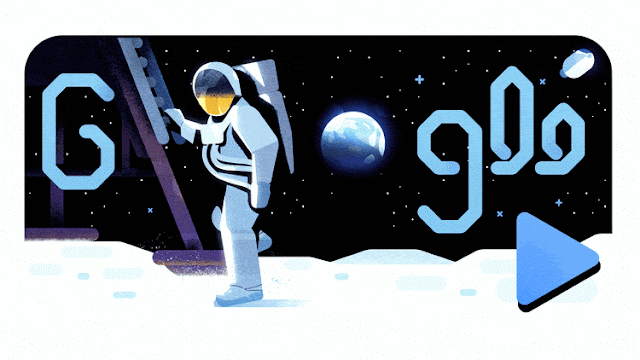Fifty years ago, NASA's Apollo 11 mission changed our world and ideas of what is possible at landing humans on the surface of the moon and bringing them home safely - for the first time in history. Today's video doodle celebrates this moment of human achievement by taking us through the journey to the moon and back, narrated by someone with firsthand knowledge of the epic event: former astronaut and Apollo 11 command module pilot Michael Collins.
A team of some 400,000 people from around the world worked on Project Apollo — mostly factory workers, scientists, and engineers who never left the ground. Within those 400,000 were the mission's astronauts Neil Armstrong, Edwin "Buzz" Aldrin, and Michael Collins. The rocket blasted off from Florida's Kennedy Space Center on July 16, 1969. After achieving orbit around the moon, the lunar module, known as "the Eagle," separated for a 13-minute journey to the surface. . Meanwhile, astronaut Michael Collins stayed behind in the command module, which would eventually bring all three astronauts back home to Earth.
Along the way to the moon's surface, Armstrong and Aldrin lost radio contact with Earth, the onboard computer showed unfamiliar error codes, and fuel ran short. As millions watched on television with anxious anticipation, they successfully steered the module to a safe landing on the crater dubbed the "Sea of Tranquility" on July 20, 1969.
Not long after, Armstrong became the first human to step on the moon, stating the now infamous words "That one small step for [a] man, one giant leap for mankind."
Returning safely to Earth on July 25, 1969, the Apollo 11 crew was followed by 10 more astronauts, with the final mission taking place in 1972. Countless scientific breakthroughs — from CAT scans to freeze-dried food — took place thanks to the mission to the moon.
Space exploration continues to this day, with milestones such as the International Space Station and plans for mission to Mars. Most recently, NASA's Artemis program — named for Apollo's sister in Greek mythology — aims to bring the first woman to the moon.
NASA's new Artemis lunar exploration program will land the first woman, and the next man, on the Moon by 2024. With innovative commercial and international partnerships, NASA will establish sustainable lunar exploration by 2028. Using the Moon as a stepping stone, NASA is preparing for humanity's next giant leap - sending astronauts to Mars. Click here to learn more.
Search for "Apollo 11" from your AR-enabled mobile device to discover the command module carrying Armstrong, Aldrin and Collins to the moon in augmented reality. There you can also discover stories about the mission, the spacecraft, and the people who made it possible.
Explore the story of the journey to the moon on Google Arts & Culture, in partnership with the Smithsonian National Air and Space Museum and NASA, among others.
A team of some 400,000 people from around the world worked on Project Apollo — mostly factory workers, scientists, and engineers who never left the ground. Within those 400,000 were the mission's astronauts Neil Armstrong, Edwin "Buzz" Aldrin, and Michael Collins. The rocket blasted off from Florida's Kennedy Space Center on July 16, 1969. After achieving orbit around the moon, the lunar module, known as "the Eagle," separated for a 13-minute journey to the surface. . Meanwhile, astronaut Michael Collins stayed behind in the command module, which would eventually bring all three astronauts back home to Earth.
Along the way to the moon's surface, Armstrong and Aldrin lost radio contact with Earth, the onboard computer showed unfamiliar error codes, and fuel ran short. As millions watched on television with anxious anticipation, they successfully steered the module to a safe landing on the crater dubbed the "Sea of Tranquility" on July 20, 1969.
50th Anniversary of the Moon Landing Video.
Not long after, Armstrong became the first human to step on the moon, stating the now infamous words "That one small step for [a] man, one giant leap for mankind."
Returning safely to Earth on July 25, 1969, the Apollo 11 crew was followed by 10 more astronauts, with the final mission taking place in 1972. Countless scientific breakthroughs — from CAT scans to freeze-dried food — took place thanks to the mission to the moon.
Space exploration continues to this day, with milestones such as the International Space Station and plans for mission to Mars. Most recently, NASA's Artemis program — named for Apollo's sister in Greek mythology — aims to bring the first woman to the moon.
Search for "Apollo 11" from your AR-enabled mobile device to discover the command module carrying Armstrong, Aldrin and Collins to the moon in augmented reality. There you can also discover stories about the mission, the spacecraft, and the people who made it possible.
Explore the story of the journey to the moon on Google Arts & Culture, in partnership with the Smithsonian National Air and Space Museum and NASA, among others.










LifeStory: SEO, SEM, blogging, Tip's, Latest, Review
SEO, SEM, blogging, Tip's, Latest, Review, affiliate marketing, social media marketing, how to earn money with blogging, Entertainment, Breaking News, Health Tips, LifeStory, Video, News, Sport, Trailer, WorldNews, Tips, and Tricks, Social Media. All information Provided